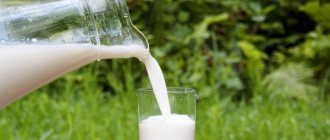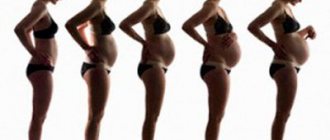Taste of breast milk
When a woman begins to breastfeed her baby, she is interested in several questions regarding breast milk.
Firstly, is the baby getting enough milk? This is especially important at the beginning of feeding when lactation has not yet fully established and the mother has little milk. Secondly, what breast milk should look like (its color and consistency). And thirdly, what the taste of breast milk is, this is most important for mothers whose children suck weakly and refuse to breastfeed. We have already covered the first two questions in articles. Let's look at the taste of breast milk in more detail, what the taste should be and what can change it.
I would like to immediately note that the tastes of an adult and a baby are very different. And just because you think breast milk tastes bad, that doesn’t mean your baby won’t like it too. There are mothers who are simply sick of the taste and smell of their milk, while their children eat it with pleasure. Let's take a closer look at what determines the taste of breast milk.
Hormones and psycho-emotional state
Does the mood of a nursing mother affect the taste of milk? Of course it is. The mother’s negativity, expressed in the form of nervousness and anxiety, will certainly be passed on to the toddler. Hormones can greatly affect the taste of milk and make it unusual and unpleasant for the baby. When the mother is in a great mood, the baby will suck milk with pleasure.
During menstruation
Young mothers often worry whether they should continue breastfeeding their baby during menstruation? Under no circumstances should lactation be interrupted. Menstruation does not make any drastic changes in the quality of milk. At the beginning of menstruation, a slight decline in milk production is possible, which is associated with some hormonal imbalance, but after two days lactation will resume with the same intensity.
Sometimes babies get nervous because there is little milk coming in or its coming is very slow. The sucking process becomes more difficult and prolonged. Advice for moms in this case: drink more fluids! The mother should drink at least 2 liters of clean water per day. This volume does not include the rest of the liquid (soups, teas, etc.).
To prevent your baby from suffering from the first lack of milk, you can start introducing complementary foods during this period.
During pregnancy
A nursing mother expecting her second child is faced with a sharp change in hormonal levels. This leaves its mark on breast milk. Its consistency, taste and composition change. Milk acquires a salty taste, which is why many babies refuse to breastfeed, and mothers are forced to switch to an artificial type of feeding.
Doctors believe that breastfeeding is absolutely compatible with pregnancy. The baby’s positive response to the changed milk, his willing attachment and active sucking should tell you that you should not interrupt breastfeeding. Lactation can be maintained until childbirth. The only reason why doctors can prohibit breastfeeding is an increase in the tone of the uterus during active sucking.
Exercise stress
If you want to lose extra pounds, you will have to give up your usual intense workouts. Increased physical activity will lead to the appearance of lactic acid in the muscle tissue, which, in turn, will give mother's milk a bitter taste. A little sporting activity will be quite appropriate, as will long walks in the fresh air. If you have an irresistible desire to exercise intensely, you should express milk after each workout.
Physical activity after childbirth should be moderate
Taste of breast milk
A newborn becomes familiar with the taste of breast milk immediately after birth; this is the first thing he tastes. He gets used to the taste, and if the mother does not change her lifestyle and diet, then the taste of breast milk does not change much during the entire period of breastfeeding. I would like to immediately note that the taste of breast milk is not constant, it can change even during the day, children, as a rule, do not react to this unless there are some strong taste changes.
Proper balanced nutrition for a nursing mother, absence of illness, proper work and rest schedule, lack of stress, and giving up bad habits guarantee good quality and quantity of breast milk. And accordingly, the composition of breast milk and its taste will satisfy the baby.
It is worth noting right away that there is no direct connection between the composition of breast milk and the food that the mother ate. Breast milk is formed from the components of lymph and blood; it is from there that all the necessary substances come from to meet all the needs of the baby. The taste of breast milk can be affected by certain medications, food additives, seasonings and spices. As well as some products with a pronounced specific taste.
Such products, for example, include spicy, salty, fatty, smoked, pickled and carbonated foods. Not only do they change the taste of breast milk so that the baby refuses it, but they can also cause colic and an allergic reaction in the baby.
There are also other products that, on the contrary, improve a child’s appetite; we will talk about them below.
Mastitis and milk stagnation can also change the taste of milk. It becomes saltier, as these pathological conditions increase the level of sodium salts in breast milk. You should pump regularly and the salty taste will go away in less than 7 days.
What breast milk should taste like
The taste of breast milk is usually lightly sweet without any harsh notes, similar to the protein shake that athletes drink to gain weight.
What reactions can you expect from children?
Children react differently to changes in the taste of their food. This depends on the individual characteristics of the child, and on how much his usual taste has changed. Many babies continue to breastfeed happily regardless of the mother's nutrition or the day of her cycle, while others become dissatisfied.
In the second case, the matter is most often limited to whims of varying degrees of duration, so time and patience will be your main allies: when the taste of the milk returns to normal, everything will get better again. But some babies are able not only to refuse several feedings, but even to wean themselves from the breast due to a change in the taste of their favorite food.
When thinking about what your breast milk tastes like, remember that it is still intended for a baby, not an adult. What may seem sickly sweet or tasteless to you is the best treat in the world for your baby. The mother’s main task is to give the baby maximum benefit, and therefore she should lead a healthy lifestyle, give up bad habits, trust nature and be patient.
Does your baby flatly refuse to breastfeed? According to experts, this can happen if the mother’s taste in breast milk has changed.
Eating herbs and spices.
Indeed, this is the most common reason why the taste of mother’s milk spoils - many seasonings, onions, and garlic add “bitterness” to it.
However, the modern view of a nursing woman's diet is much less liberal than it was several decades ago. Food should not be meager and tasteless, like that of a fasting monk, but varied and balanced. In other words, if a nursing mother wants a fresh salad with onions, there is no need to refuse this dish. Just pour boiling water over it before chopping the onion. Well, of course, you should eat it in reasonable quantities. If you want, for example, garlic, add one clove to the minced meat and cook oven or steam cutlets.
By the way, some nursing mothers, on the contrary, claim that their children breastfeed better if the menu included dishes with seasonings.
Restoring the menstrual cycle in a nursing mother.
This opinion also exists, but it refers rather to a hypothesis. There is no reliable evidence of a connection between the beginning of “these days” and the taste of breast milk. Although thousands of breastfeeding women say that during this period their babies refused to breastfeed. Some experts explain this by the fact that when menstruation begins, body odor changes. The child hears an unfamiliar smell from his mother, naturally, it frightens him and worries him. As a rule, after a few days the baby gets used to it and there is no threat to breastfeeding.
Repeated pregnancy.
If conception occurs during breastfeeding, the taste of mother's milk will inevitably change. This is due to hormonal changes that begin in the body of a pregnant woman. The baby may be restless at the breast. However, after a few days the baby will adapt and accept the new taste of mother's milk.
Lactostasis.
Stagnation of milk in the ducts of the mammary glands leads to an increase in the level of sodium salts in the body. As a result, breast milk may have a salty taste. As a rule, a week after treatment of lactostasis, the taste of breast milk becomes familiar to the child.
Taking medications.
Some medications allowed during lactation, however, may adversely affect the taste of mother's milk. For example, antibiotics give it a so-called “metallic” taste.
Weaning period.
As breastfeeding becomes less frequent, less and less milk is produced. This leads to a significant decrease in the level of lactose in it - it is this carbohydrate that milk owes its sweetish taste. At the same time, the level of salts increases, which will affect the taste of mother's milk.
It is important to understand that all these reasons are not a reason to stop breastfeeding. Moreover, if the baby is capricious at the breast, unobtrusive attempts to breastfeed should be repeated again and again until the baby gets used to the new taste and smell of milk.
In general, the composition of breast milk is an extremely variable substance. It is influenced by the diet of the nursing mother, the feeding period, the age of the child, etc. “Morning” milk may differ from “night” milk, just as “winter” milk from “spring” milk. But no matter what the taste and smell of mother’s milk, it is the healthiest food for a child under one year old.
What determines the taste of breast milk?
We've already said that breast milk can change the taste for a number of reasons. Some of them may have no effect on the baby's appetite, others may stimulate it, and still others may lead to a refusal to breastfeed. Let's take a closer look at them.
Does food affect the taste of breast milk?
The baby became acquainted with your gastronomic preferences in utero, swallowing amniotic fluid. Therefore, if you stick to the same menu, do not worry that your baby will refuse breast milk if its taste changes in response to familiar foods.
Nutrition should be balanced and varied; if you want something, you should not deny yourself it, you just need to comply with the following conditions. New foods that you have not eaten regularly before should be introduced one at a time. Then you should carefully look at the child’s reaction - if the appetite has not changed, this product can be included in your menu. It is better to introduce new exotic foods into your diet after 6 months, since before this time the baby’s intestinal lining is still immature and normal microflora has not been established. Therefore, the baby may be very sensitive to certain foods.
When breastfeeding, your baby indirectly gets used to the menu familiar to your family, which in the future will help him easily adapt to the family kitchen, and he will not have allergic reactions to these products.
Introducing new products to the menu allows the baby to develop his taste buds and form taste preferences.
Foods that affect the taste of breast milk
This is exactly the product that causes an increase in appetite in most children. We can safely say that garlic improves the taste of breast milk. Experiments conducted in England prove this. When nursing mothers ate garlic, their babies suckled more often, more, and more intensely. A specific taste in breast milk appears 1-2 hours after eating garlic.
Gives an unusual taste to breast milk; many children suckle this milk willingly. The change in the taste of milk from onions occurs faster than from garlic.
Consuming large amounts of glucose: pastries, cakes and other sweets make milk taste sickly sweet. Some babies don't like it and are reluctant to breastfeed.
When vanilla is consumed, milk acquires a sweet smell and taste reminiscent of vanilla. Usually moms like it better, and children are usually neutral.
In small quantities it does not cause any obvious changes; a faint piquant odor may be observed.
Peppered and spicy foods consumed in large quantities can add notes of bitterness to the taste of milk. Some kids don't like it.
Curry, cumin, basil
Seasonings give breast milk a spicy taste and smell. Some children may not like it.
In small quantities it has no effect (sometimes you can drink tea with mint), but in large quantities it can add bitterness to the milk.
Radish and radish
You should not overuse these products, as they make breast milk bitter.
Makes milk taste sweet, many children like it.
Zucchini, potatoes and any cabbage
They make milk more bland, without any strong tastes.
We have looked at which products spoil the taste of breast milk and which make it more attractive to the baby. Let's look at how bad habits change the taste of milk.
Does alcohol affect the taste of breast milk?
It has been scientifically proven experimentally that drinking alcohol by a nursing mother causes a refusal of breast milk altogether or reluctant breastfeeding, since ethyl alcohol imparts bitterness to the milk. In addition, alcohol enters the child’s body through mother’s milk and has a toxic effect on the neurons of his brain. The maximum concentration of alcohol in breast milk is reached 0.5-1.5 hours after drinking alcohol. There is no accumulation of alcohol in breast milk; it is eliminated simultaneously from the entire mother’s body, so pumping or drinking heavily does not reduce its concentration in breast milk. The duration of elimination depends on the dose and concentration of alcohol - the more you drink, the longer it takes to eliminate, up to 24 hours.
It is a mistaken belief that red wine and beer are good for lactation; any alcohol suppresses the formation of milk. And besides this, no one has canceled the toxic effects of alcohol on the body, especially on growing children.
What is breast milk and where does it come from?
During pregnancy, a natural mechanism is launched in a woman’s body to provide adequate nutrition for the little person. All the “gears” of the mechanism act harmoniously, like in a model factory.
Breast milk is a product that is produced from particles formed by blood and lymph. These fluids are filled with beneficial substances isolated from the mother's food. Milk is created and stored in the alveoli - miniature bubbles of glandular tissue located in the female breast. The alveoli are collected in clusters, from them the milk ducts stretch to the nipple.
Alveoli with milk, adjacent to the chest muscles, are connected to the nipple by ducts
The hormone prolactin, the production of which begins during pregnancy, stimulates milk production. However, two other hormones - estrogen and progesterone - initially do not allow prolactin to “expand to its full potential”: otherwise rivers of milk would flow from the nipples even before the baby is born. Only on the eve of childbirth, prolactin becomes the main hormone, and with the birth of a new person, the mother’s body begins lactation - milk production.
In order for the nutrient fluid to flow from the alveoli through the ducts without interference and the newborn to be able to easily “extract” food from the nipples, another hormone is activated - oxytocin. It is responsible for the contraction of muscle fibers. Thanks to oxytocin, the ducts in the nipples widen, making it easier for milk to flow directly into the baby's mouth. And a nursing mother feels like her chest is literally “expanding.”
Flows and changes: stages of milk formation
During the formation process, breast milk goes through several stages:
- Colostrum. Thick yellowish liquid with a high concentration of nutrients and antibodies; Colostrum helps the newborn adapt to a new method of nutrition and provides protection against allergies and infections. A little water: until the baby’s kidney function has improved, the need to drink is minimal. Colostrum contains a large amount of proteins, natural antioxidants - vitamins A, E, beta-carotene. Produced in the first four days after birth.
- Transitional milk. At first yellowish, then turns white. This product increases the amount of carbohydrates that stimulate the growth of a small organism. Transitional milk nourishes the baby until he is one month old.
- Mature milk. White or with a bluish tint. Saturated with carbohydrates and fats, which increases energy value, and proteins are two to three times less than in colostrum; the concentration of antioxidants is also lower. During the day, the amount of mature milk reaches one and a half liters.
It is sometimes said that breast milk has three ages.
Metamorphoses of breast milk: depending on “age” it changes composition and color
After 6 months, the composition of the milk changes again: the level of immunoglobulin increases, the energy value increases - so that the baby develops healthy and strong. And during teething, there is more calcium in breast milk.
The quality of the nutrient fluid varies from case to case due to the following factors:
- time of day—mother’s milk is thicker during the day, thinner at night;
- weather conditions - in hot weather milk thins out (so that the baby can quench his thirst better), and in cold weather it thickens;
- mother’s well-being - weak immunity, taking medications changes the color and taste of the product;
- the strength and diligence of the child - if the baby sucks actively, breast milk becomes fattier.
When a baby is put to the breast, the nerve endings in the nipple are stimulated; a signal goes to the mother’s brain - “give prolactin!” – and the production of the hormone increases. This means the amount of breast milk increases. As a result, as much as the baby ate, that’s what his mother’s “dairy factory” produced.
According to various sources, a woman’s milk contains from five hundred to a thousand components, most of which scientists have not yet been able to accurately reproduce. In addition to valuable substances, the nutrient liquid contains approximately 700 types of beneficial bacteria - they form the intestinal microflora - as well as some harmful microbes, so that the baby’s immune system learns to resist infections.
It’s hard to believe that such a drink, thought out to the last detail, was created outside the walls of a modern laboratory and without human intervention at all; This miracle was given to us by biological evolution.
A little more about the composition of breast milk
Mature mother's milk consists of 88% water, so there is no need to give the baby additional water. The remaining 12% contains a storehouse of useful substances. Every nursing mother has a full range of valuable elements in the fluid produced by the mammary glands.
Table: Nutrients in Breast Milk
| Name | quantity in 100 g of milk | benefits for the baby's body |
| squirrels | 1.3 g | A base for the growth of a small organism; among the main proteins:
|
| fats | 4.2 g | Strengthen the immune system, form the central nervous system; cholesterol promotes the production of vitamin D; the main hormones also belong to fats. |
| carbohydrates | 7 g | Breast milk contains lactose, which:
|
| chlorine | 43 mg | Normalizes digestion, supports the functioning of the liver and circulatory system. |
| calcium | 35 mg | Responsible for the formation of the skeletal system and participates in the mineralization of bone tissue. |
| sodium | 15 mg |
|
| phosphorus | 15 mg |
|
| iron | 76 mcg | Responsible for the production of the blood protein hemoglobin, which carries oxygen to organs and tissues (with a lack of oxygen, the heart and brain are primarily affected). In addition, iron:
Despite the small amount in milk, it is absorbed by 70% (from artificial milk mixtures - only 10%). |
| vitamin A (retinol) | 60 mcg | Considered a growth and vision vitamin. Besides:
|
| vitamin C (ascorbic acid) | 3.8 mcg |
|
| vitamin D (calciferol) | 0.01 mcg |
|
The energy value of 100 g of breast milk is 280 kJ; Average caloric content is 67 kcal.
Types of breast milk
The fattier the milk, the less it is contained in the mammary glands. But even within the same gland, the fat content of the nutrient fluid is different. It depends on the type of milk. There are:
- foremilk - liquid, bluish in color; secreted in the first minutes of feeding, since it is located next to the excretory ducts of the glands; contains a large amount of water (so that the baby can better quench his thirst), as well as salts and carbohydrates;
- hind milk - thick, yellowish in color; enters the ducts after 15–20 minutes of feeding the baby; rich in nutrients, therefore it is considered a complete food for a growing body; improves intestinal microflora.
If the product of the mammary glands is bluish in color, then it is foremilk; if the color is white-yellow - hindmilk, fattier
The more often a nursing mother puts her baby to the breast, the more hindmilk is produced.
It happens that the baby is capricious: having sucked the foremilk from the breast, he does not want to “work” further. Mom readily exposes her other breast. In vain. The baby will never taste the best milk, receiving only a thin version from both breasts. The result is indigestion and slow weight gain.
To help your baby get enough of hindmilk, try:
- apply more often to the chest; if the break between feedings is long, the milk separates, the watery part approaches the nipple, and the thick part remains in the depths of the breast;
- make sure that the baby sucks correctly, grasping the entire nipple with his mouth, as well as part of the areola - then he will be able to draw out both foremilk and hindmilk;
- when the baby “shirks from work”, take a break from feeding; After some time, offer the breast again - now he is unlikely to refuse.
“Competent” breast sucking is an important factor: when the baby latches on to the entire nipple, the breast is completely emptied
Some mothers resort to a trick, expressing foremilk so that the baby gets only hindmilk. However, in this case, the baby will not receive enough liquid, which quenches thirst and helps digest dense food.
What are the benefits of feeding?
The product obtained from female mammary glands has no equal from a practical point of view because:
- has no expiration date because it does not spoil;
- does not need cooking;
- doesn't cost a penny.
The emotional aspect is also important: during feeding, the mother receives an inoculation against stress; The woman develops a maternal instinct and develops a feeling of attachment to the baby. In turn, the baby at the mother’s breast feels peace, protection from fears or ailments, and therefore often falls asleep after sucking.
According to scientists, children fed with breast milk grow up strong, sociable, and with a positive outlook on the world.
What does the taste of breast milk depend on?
Many mothers, being at the initial stage of breastfeeding, wonder what their milk should taste like.
Often, for an adult, including the mother herself, breast milk may seem tasteless. This doesn’t mean at all that the baby won’t like it either. If you eat right (I mean a healthy diet for a nursing mother) and give up bad habits, then you don’t have to worry about the taste of your milk becoming unpleasant for the baby.
But there are a number of reasons why milk can change its taste. Many of them will not affect in any way the feeding of your baby, but others may be the decisive reason for breastfeeding.
Let's consider some factors:
Foods that mom eats.
The baby has already tried everything that was in your diet during pregnancy by swallowing amniotic fluid. Therefore, it is unnecessary to worry that your baby will refuse your milk if it changes taste in response to the food that is included in your diet.
Do not think that any product you eat will impart its taste to milk. There is no direct connection between the composition of milk and the food eaten by the mother. Milk is formed from the components of lymph and blood, and not from the gastric filling of the nursing mother. Only artificial additives and drugs enter milk in their true composition.
Eating your favorite foods without limiting yourself to strict dietary restrictions is the best solution for a nursing mother. In this way, the child develops taste and preference in accordance with the products that are used for food in your family.
The taste of mother's milk depends on the foods she consumes, which can help the baby get used to family cooking.
When a nursing mother eats a varied diet, her baby will learn “33 tastes” in a week.
Undoubtedly, during the first 6 months of life, the immature lining of the baby's intestines can acutely perceive any products that enter through mother's milk. Also, do not forget about allergenic foods that must be introduced into the mother’s diet gradually and in small doses.
I decided to conduct a personal experiment, using foods that, according to experts, greatly change the taste of milk.
Garlic : 1-2 hours after consumption, milk develops a taste vaguely reminiscent of garlic.
From my personal experiment, the milk began to taste of garlic after a bowl of “Jewish” salad (grated processed cheese with garlic), and had a slightly pungent smell. The next day the taste of the milk became the same.
Expressed breast milk smells bad - what to do?
In order to reduce the likelihood of an unpleasant odor in expressed milk, it is necessary first to identify and eliminate errors during storage.
• Storage containers: Standard plastic or glass milk storage containers (or any other leak-proof storage containers) are suitable for storing breast milk, as are special disposable bags or disposable bottle liners.
Plastic bags (bottle liners) do not preserve the nutrients and immune properties of milk as well as glass or hard plastic (Jones{amp}amp;Tully 2005).
- If you use regular plastic bottle liners, try replacing them with special liners suitable for storing breast milk.
- If you store in plastic, try replacing it with glass.
(you can see what else mothers use to store expressed breast milk here – editor’s note)
• Storage conditions: do you plan to freeze the milk? If you are not going to use it within 5-8 days, freeze it as quickly as possible after pumping. Also use the milk as soon as possible after defrosting (and always within 24 hours).
- Make sure all containers in the refrigerator or freezer are well sealed to prevent milk from absorbing odors from other foods. A pack of baking soda in the refrigerator or freezer will help get rid of odors.
- Store it near the BACK of your refrigerator or freezer, not on the door. Do not store milk near the wall of a self-defrosting freezer.
- Is your freezer cold enough? If the ice cream stays hard in the freezer, it's the right temperature.
Expressed breast milk tastes or smells like soap - has it gone bad?
Sometimes refrigerated or frozen milk develops a soapy odor or taste, even if all storage procedures are carefully followed.
There is speculation (Lawrence {amp}amp;Lawrence (p. 781) that some women have an excess of lipase enzyme in their breast milk, which begins to quickly break down milk fat after pumping. For most babies, small changes in taste do not matter and the milk is safe, but The stronger these changes, the greater the likelihood that the baby will refuse milk.
• Lipase helps maintain the smoothness of milk fat and whey (in an emulsified state), and also keeps the fat particle size small for better absorption (Lawrence{amp}amp;Lawrence, p. 156).
• Lipase also breaks down the fats in milk so that fat-soluble nutrients (such as vitamins A and D) and free fatty acids (which protect the baby from disease) are easily absorbed by the baby (Lawrence{amp}amp;Lawrence, p. 156).
• The main lipase in human milk, bile salt-activated lipase (BSSL), “has been shown to be the major protozoan inactivating factor” (Lawrence{amp}amp;Lawrence, p. 203).
According to research by Lawrence{amp}amp;Lawrence (p. 158), the amount of BSSL lipase in each mother's milk does not change during each feeding and remains the same at different times of the day or at different stages of lactation. There is evidence that lipase activity may decrease over time in malnourished mothers.
What should I do if bad odor in breast milk is caused by excess lipase?
If milk has acquired a sour or rancid taste/smell, it can no longer be used. However, newly expressed milk can be preserved by heating it to the point where lipase is destroyed and the fat breakdown process is stopped. Warm it up as quickly as possible after pumping.
• Heat milk to 82 degrees Celsius (180 Fahrenheit) or until small bubbles appear at the edge of the pan (do not bring to a full boil).
• Cool quickly and store.
(fast heating technology is also described in the article “Pasteurization at home” - editor’s note)
Heating milk destroys the anti-infective properties of the milk and may reduce some nutritional properties, but this will likely not be a problem unless all the milk the infant receives is heated.
According to research by Lawrence{amp}amp;Lawrence, BSSL lipase can also be destroyed by heating milk at 62.5 degrees Celsius (144.5 Fahrenheit) for one minute (p. 205) or at 72 degrees Celsius (163 Fahrenheit) for 15 seconds (p. 771).
What should I do if the milk has a sour or rancid taste/smell rather than soapy?
• Do not use regular drinking water (do not drink or allow water to come into contact with milk)
• Avoid fish oil, flaxseed and foods containing rancid fats such as anchovies.
• Increase your intake of antioxidants, including beta carotene and vitamin E.
• Try mixing “rejected” frozen milk with fresh milk. Start with half frozen and half fresh, and adjust the amount of frozen milk (more or less) depending on your baby's preference.
• Donate your frozen milk to children in need. In the US and Europe you can donate it to a milk bank. Lipase and other taste changes are not usually a problem for milk banks.
For most children who are supplemented with donor milk, the soapy taste and smell also do not matter; they are used to it. If you live in the United States, you can find information about a milk bank near you on the HMBANA website.
Berkow SE, Freed LM, Hamosh M, Bitman J, Wood DL, Happ B, Hamosh P. Lipases and lipids in human milk: effect of freeze-thawing and storage. Pediatric Res. 1984 Dec;18(12):1257-62.
Bitman J, Wood DL, Mehta NR, Hamosh P, Hamosh M. Lipolysis of triglycerides of human milk during storage at low temperatures: a note of caution. J Pediatr Gastroenterol Nutr. 1983;2(3):521-4.
Dupuy P, Sauniere JF, Vis HL, Leclaire M, Lombardo D. Change in bile salt dependent lipase in human breast milk during extended lactation. Lipids. 1991 Feb;26(2):134-8.
Hamosh M, Dewey KG, Garza C, et al. Nutrition During Lactation. Institute of Medicine, Washington, DC, National Academy Press, 1991. pp. 138.
Jones F, Tully MR. Best Practice for Expressing, Storing and Handling Mother's Milk in Hospitals, in Homes and in Daycares, 2nd ed. Raleigh, NC: Human Milk Banking Association of North America, 2006: 14-15, 20.
We suggest you read: Breastfeeding diet for weight loss: how to lose weight for a nursing mother
Lawrence R, Lawrence R. Breastfeeding: A Guide for the Medical Profession, 6th ed. Philadelphia, Pennsylvania: Mosby, 2005: 156-158, 203-205, 771, 781.
May JT. Table 7: Effect of heat treatment or storage on antimicrobial factors in human milk. From: May JT. Molecular Virology: Tables of Antimicrobial Factors and Microbial Contaminants in Human Milk. Accessed 9/8/05.
May JT. Antimicrobial properties and microbial contaminants of breast milk–an update. Aust Paediatr J 1984 Nov;20(4):265-9.
Mohrbacher N. Breastfeeding Answers Made Simple. Amarillo, Texas: Hale Publishing, 2010: 460-461.
Diet of a nursing mother: what to eat to make breast milk tasty and healthy for the baby?
The content of the article:
Breastfeeding is a natural process established by nature itself. The unity of mother and baby helps the newborn to feel love and care, and the mother to establish a psycho-emotional connection with the baby.
And in order for the feeding process to be painless for two, you need to find out how the nutrition of a young mother affects the quality and taste of breast milk.
Foremilk and hindmilk: what is the difference?
Many breastfeeding women are faced with a situation where a translucent liquid is released from the breast instead of the usual white milk. It is called foremilk and, contrary to popular belief, it does not at all signal that a woman has any problems.
In the intervals between feedings, the milk in the breast is divided into two parts: the more liquid is concentrated at the exit to the ducts, and the fatty and thick is deposited on the walls of the cell that secretes milk. But this does not mean that the mammary glands produce two types of milk - nature simply arranged everything so that the child can quench both thirst and hunger in one feeding. So the baby first receives foremilk, which has a pale tint - it is rich in carbohydrates and quenches thirst. The baby is then fed hindmilk, which is rich in fats needed for growth.
Since milk changes depending on the baby’s needs, the baby receives nutrition of different consistency. But if you put your baby to the breast more often, the milk will become more homogeneous. When feeding, it is important to ensure that the little one empties the breast completely, otherwise he may not drink hind milk and will quickly want to eat. During feeding, it is better to give the baby only one breast, and not both at once. The exception is when a woman has a lack of milk.
How does a mother's diet affect the quality of her baby's milk?
Healthy and nutritious nutrition of the mother determines the composition of breast milk and its quantity.
The protein that enters the body with mother's milk is one of the main components responsible for the growth of the child and the formation of his nervous system. A lack of protein in a baby's body can negatively affect its development.
An excess of easily digestible carbohydrates in the mother's diet (confectionery, honey, sugar, jam, chocolate, breakfast cereals, grapes and bananas) makes breast milk very sweet. Such milk can cause dysbiosis in a newborn.
That is why it is important for a nursing mother to remember that sugar in her body is released not only from sweets, but also from other foods, and then in the right amount enters the baby’s body with breast milk in the form of milk sugar (lactose).
Colostrum
The very first portions of milk - colostrum - appear in the breasts in the second trimester of pregnancy. Some women even release it before giving birth, but this is not a cause for concern. The color also varies from transparent to orange, the viscosity is quite high.
The composition of colostrum differs from breast milk - it contains practically no fat, but a large amount of proteins and vitamins, and contains leukocytes and immunoglobulins.
Main functions of colostrum
:
- Protecting the newborn from disease.
- Populate his intestines with beneficial bacteria, thereby preparing him for the absorption of breast milk.
- Have a laxative effect on the intestines to remove miconium (original feces).
- Prevent the development of newborn jaundice (promote the breakdown of bilirubin).
The first portions of colostrum that the baby sucks are proportional to the size of his stomach and are very small.
Important! Don't worry about your baby losing weight in the first few days after birth. This is normal, the main thing is to apply it to your breast regularly, if possible - on demand!
On days 3-5, colostrum will be replaced by transitional milk, which is a mixture of breast milk and colostrum.
What foods should be included in a nursing woman's diet?
The daily calorie intake for a young mother is 3000-3200 calories. This is enough for both mother and baby - the energy expenditure for one breastfeeding is 500-800 calories , the rest will serve as energy for the mother herself. But exceeding the norm can provoke hypogalactia - a decrease in the amount of breast milk until it disappears.
To ensure that the baby and mother feel good, pediatricians recommend that nursing women adhere to the 1-1-4 rule - this is the ratio of proteins, fats and carbohydrates, and consume healthy foods in quantities sufficient for two.
- Lean fish (protein, vitamin D).
- Dairy and fermented milk products (protein, calcium).
- Liver (folic acid).
- Cereals (millet, oatmeal, buckwheat – vitamin B1).
- Cottage cheese, cheeses (vitamin B2).
- Butter, eggs, pork, beef liver (vitamin A).
- Carrots, greens (beta-carotene).
- Red bell pepper, currants, sea buckthorn (vitamin C).
- Walnuts (increase the fat content of milk, making it more nutritious).
Pediatricians strongly recommend including iron-rich foods ( liver, meat, eggs, figs, blueberries, black currants, buckwheat ) in the mother’s diet.
You should also not forget about the rules for taking fluids: the daily fluid intake for a nursing woman is no more than 2 liters. Excess fluid impairs the properties of breast milk, making it watery and diluted.
The baby is growing
As the baby grows, the composition of the milk adapts to its growing needs. During the period of active growth, the milk will be more saturated with proteins, teeth will begin to cut – the calcium content will increase.
It is a mistake to believe that after a certain age (we traditionally believe that after a year and a half) milk no longer provides any significant benefit to the child. On the contrary, it is precisely at the moment when it ceases to be the main supplier of building materials - proteins, energy in the form of fats and carbohydrates, that milk will acquire the properties of an immunomodulator
.
Interesting fact: breast milk contains more than 400 components, some of which (the same immunoglobulin) the baby has nowhere else to get!
Many pediatricians have noticed that breastfed children up to 2-3 years of age get sick less often and tolerate infectious diseases more easily. Therefore, you should stop breastfeeding only when the mother herself is psychologically tired of it.
Products not recommended for breastfeeding
In the first months of life, the child is especially sensitive to substances that come with mother's milk, so the young mother should pay special attention to composing her diet. Improper nutrition of the mother can cause diathesis, colic, bloating, and diarrhea in the child.
- White cabbage, Brussels sprouts, broccoli (cause bloating and cause colic in the baby).
- Legumes (provoke flatulence in a newborn).
- Citrus fruits (can provoke diathesis).
- Smoked meats (contain harmful substances that can cause allergies in a child).
- Fried and fatty foods (promotes colic).
- Mushrooms (can cause severe digestive upset in a baby).
- Large quantities of pasta and baked goods (cause fermentation and gas formation in the child).
- Carbonated drinks (dyes contained in drinks can cause allergies in a newborn).
- Coffee (stimulates the child’s nervous system).
Prohibited Products
The taste of milk directly depends on the nutrition of a nursing woman. Do not overuse garlic - many babies do not like the taste of milk after it. It is also better to postpone spicy seasonings and smoked foods until better times.
Reasons why newborns refuse to drink breast milk
There are several main reasons why a baby refuses mother's milk:
- Improper nutrition of the mother - if a woman eats spicy, fatty, smoked foods, onions, garlic and various spices, then her milk may acquire an unpleasant taste for the baby. Medicines and herbs can also change the taste of milk. Before taking any medications, a nursing mother should consult a doctor.
- Teething - this painful process for the baby can be the reason for breast refusal. Pay attention to your child's gums - if they are swollen and enlarged, it means he is teething.
- Bottle feeding is another reason to avoid breastfeeding because a bottle makes it much easier for your baby to suckle. Having become accustomed to receiving it quickly and effortlessly, the child refuses his mother’s breast.
- Runny nose - when a baby’s nose is stuffy, he cannot suck milk and breathe at the same time, so before feeding you should clear the baby’s nose of dry crusts and mucus.
During the period of breastfeeding, a woman gives her baby more than just milk - she boosts the baby’s immunity, lays the foundations for his health, but most importantly, the mother gives her love.
During feeding, the baby feels protected next to his mother. This is what makes feeding a newborn doubly comfortable and enjoyable. On the other hand, mothers who have lost milk do not need to reproach themselves - it is important to learn to give their love to the baby in a different way.
If mom is sick
Very often, when mothers become ill, they stop feeding and wean the child from the breast. Although it is through breast milk that he will receive the necessary antibodies and will not get sick.
High temperature is also not an obstacle to breastfeeding. Human milk is extremely heat-resistant - it does not disappear at 130 degrees for 50 minutes, which is just 38.5C.
If for some reason lactostasis or mastitis occurs, the milk acquires a salty taste that does not disappear within a week. But! The baby can and should be placed on the sore breast. It is he who will be able to properly dissolve the breast, relieving lactostasis.
Rules for creating a menu for a nursing woman
The main principle of creating a diet for a nursing woman is the mother’s needs and the baby’s reaction to certain foods. Everything should be tasty and healthy for both you and your child.
- We focus on those products that are allowed and do not cause health problems for the child. From the 2nd month of the baby’s life, we gradually begin to introduce one new product into the mother’s daily diet.
- When preparing a dish, it is advisable to follow the rule of light food processing (cook in a double boiler, slow cooker, bake in the oven, stew in a tightly sealed container).
- We do not consume products containing preservatives, dyes, thickeners, flavor enhancers, as well as exotic fruits and vegetables.
- During the first month of a child’s life, we do not consume foods that cause bloating and colic in the baby.
- If an allergic reaction occurs in the baby, we gradually exclude foods that may be the cause.
- The best drinks for a nursing mother to drink are water, dried fruit compote, and tea.
- The diet of a nursing woman should be complete and not skimpy in terms of food - the richer your menu, the better.
Taste and smell
Mother's milk is the first food that a newborn tries while still in the maternity hospital. Its taste becomes familiar to the baby. A mother, adhering to her chosen diet and lifestyle throughout the entire lactation period, will most likely maintain the taste of mother's milk constant. Let us note the fact that milk has the ability to change its flavor even within one day.
It is important for everyone to remember that a mother’s diet does not affect the taste of breast milk. All sources for feeding the baby come from the mother’s blood and lymph. We also note that a number of medications, food additives present in products, as well as spices, can change the taste of milk to a significant extent. You can also add products that have a bright, specific taste.
The diet of a nursing mother does not affect the taste of milk, unless she eats foods with a very strong aroma
Menu for 7 days
When creating an individual diet, use the lists of permitted and prohibited foods, and try to diversify your diet as much as possible.
Monday:
Breakfast. Buckwheat porridge in water with sunflower oil, dried fruit compote. Dinner. Chicken breast soup, 200 g mashed potatoes. Afternoon snack. Stewed vegetables (carrots, zucchini, eggplants, bell peppers, onions). Dinner. A glass of kefir.
Tuesday:
Breakfast. Cheese pancakes with sour cream, tea. Dinner. Soup with buckwheat and boiled meat, 1 quail egg. Afternoon snack. 200 g cottage cheese casserole with cherries. Dinner. 200 g beet salad with olive oil.
Wednesday:
Breakfast. A glass of yogurt. Dinner. Soup with beef meatballs, 100 g of rice with stewed vegetables. Afternoon snack. Baked apples (green) in dough. Dinner. 200 g vegetable stew.
Thursday:
Breakfast. Kefir, biscuits. Dinner. Fish soup, 100 g buckwheat porridge, 1 chicken egg. Afternoon snack. Fruit of your choice (peach, several plums) and 30 g of walnuts. Dinner. Mashed potatoes, 100 g boiled chicken breast, 50 g steamed asparagus.
Friday:
Breakfast. Cottage cheese casserole with dried fruits, tea. Dinner. Vegetarian vegetable soup with sour cream, 100 g oatmeal, 100 g boiled turkey. Afternoon snack. A piece of watermelon. Dinner. White omelette.
Saturday:
Breakfast. Baked apples with currants, dried fruit compote. Dinner. Vegetable puree soup (onions, carrots, celery root, potatoes), 100 g of baked rabbit meat with sour cream. Afternoon snack. A glass of yogurt. Dinner. Fish baked with vegetables.
Sunday:
Breakfast. 1 quail egg, 50 g hard cheese, tea. Dinner. Chicken broth, 200 g vegetable stew. Afternoon snack. Cottage cheese casserole. Dinner. 100 g boiled turkey, stewed vegetables.








